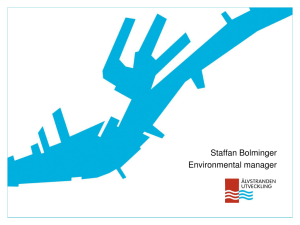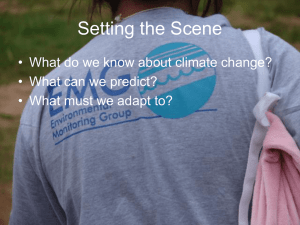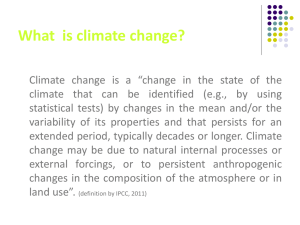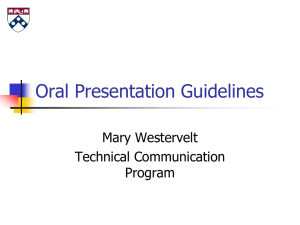Click here to the workshop slides
advertisement
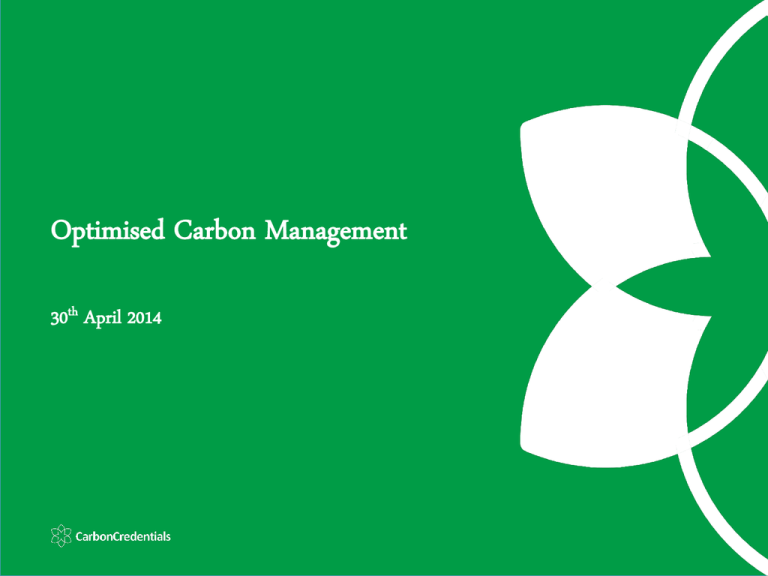
Optimised Carbon Management 30th April 2014 Introduction to Carbon Credentials Professional Services Overview People, Processes, Technology Our industry recognised People are expert in their fields of compliance, carbon, energy and sustainability. We develop robust & efficient Processes for data management and analysis to enable our clients to focus on ‘action’ and ‘improvements’ not data and compliance. We use Technology for data storage and advanced analytics and visualisation to provide powerful analysis and outputs. Where Next For Your Reporting? Descriptive Analysis Looks at past performance and understands that performance by mining historical data to look for the reasons behind past success or failure. Predictive Analysis Predictive analytics answers the question what will happen. Historical performance data is combined with rules, algorithms, and occasionally external data to determine the probable future outcome of an event or the likelihood of a situation occurring. Prescriptive Analysis This goes beyond predicting future outcomes by also suggesting actions to benefit from the predictions and showing the implications of each decision option. E.g. you may find that there is a risk that you will not meet your reduction targets because of a few select assets. Therefore we can help identify where and what you need to focus on for specific performance improvement on these identified assets. Key Managed Service Clients Key Public Sector Clients Higher Education Panel Ola Bankole Sustainability Manager, Bloomsbury Colleges Group Group Fabia Jeddere-Fisher Energy Engineer, The University of the West of England of England John Taylor Senior Energy Engineer, Carbon Credentials Trends in Carbon Management Planning Your Reasons for Attending The Higher Education Balancing Act The Energy Trilemma The Value at Risk Energy Costs (£) Carbon Emissions (CO2/m2) Business as usual Energy & Carbon Performance Gap Carbon Management Optimisation Time The big picture Students in Higher Education 3,000,000 2,493,415 2,500,000 2,501,295 2,496,645 2,396,050 2,131,110 2,200,175 2,236,265 2,281,235 2,304,700 2,306,105 2005/06 2006/07 2007/08 2,340,275 2,042,580 2,000,000 1,948,135 1,500,000 1,000,000 500,000 - 2000/01 2001/02 2002/03 2003/04 2004/05 Data from HESA EMR. 2008/09 2009/10 2010/11 2011/12 2012/13 Carbon Emissions from Energy 5.5 % Data from HESA EMR. Includes 154 HEIs that have submitted returns for four years. Average Carbon Emissions from Energy per m2 Differences in metrics 8.2% Data from HESA EMR. Includes 154 HEIs that have submitted returns for four years. CRC Participant Performance 9% 2% Data from HESA EMR. Includes 154 HEIs that have submitted returns for four years. Regional Performance Average Carbon Emissions per Square Metre kgCO2/m2 Data from HESA EMR. Includes 154 HEIs that have submitted returns for four years, of which 26 are in attendance today. Regional Performance Average Carbon Emissions per FTE Staff + Student tCO2/FTE Staff + Student Data from HESA EMR. Includes 154 HEIs that have submitted returns for four years, of which 26 are in attendance today. Regional Performance Average Carbon Emissions per £1m Turnover tCO2/£1 million Data from HESA EMR. Includes 154 HEIs that have submitted returns for four years, of which 26 are in attendance today. Attendees’ Performance Carbon Emissions per m2 5.8% Overall Carbon Emissions 4.2% FY 2012 Carbon Emissions per FTE Staff + Student (tCO2) Carbon Emissions per Million £ Turnover (tCO2) National Average 1.38 92.8 Attendee Average 1.20 89.7 Data from HESA EMR. Includes 154 HEIs that have submitted returns for four years, of which 26 ar Evolution of the CMP Static Dynamic & flexible Evolution of the CMP Dynamic & flexible Scope 1 & 2 only Scope 1,2 & 3 Evolution of the CMP Dynamic & flexible Scope 1,2 & 3 Absolute Targets Relative Targets Evolution of the CMP Dynamic & flexible Scope 1,2 & 3 Relative Targets HEFCE Controlled University Driven Evolution of the CMP Dynamic & flexible Scope 1,2 & 3 Relative Targets University Driven Isolated Context & Collaborative Evolution of the CMP Dynamic & flexible Scope 1,2 & 3 Relative Targets University Driven Technical Context & Collaborative Technical & Engaging Evolution of the CMP Dynamic & flexible Scope 1,2 & 3 Relative Targets University Driven Context & Collaborative Technical & Engaging Theoretical Practical Evolution of the CMP Dynamic & flexible Scope 1,2 & 3 Relative Targets University Driven Context & Collaborative Technical & Engaging Practical Standardised Bespoke Evolution of the CMP Dynamic & flexible Scope 1,2 & 3 Relative Targets University Driven Context & Collaborative Technical & Engaging Practical Bespoke Opportunities & Barriers to High Impact Carbon Management Plans Opportunities & Barriers What could you achieve with an optimised CMP? • 3 to 5 answers for each question per table Opportunities & Barriers What could you achieve with an optimised CMP? What is inhibiting your ability to achieve this? • 3 to 5 answers for each question per table Opportunities & Barriers What could you achieve with an optimised CMP? What is inhibiting your ability to achieve this? • 3 to 5 answers for each question per table • Weight each answer: 1 (not important) to 7 (very important) Higher Education Panel Session: Ola Bankole Sustainability Manager, Bloomsbury Colleges Group Fabia Jeddere-Fisher Energy Engineer, The University of the West of England John Taylor Senior Energy Engineer, Carbon Credentials Fabia Jeddere-Fisher Energy Engineer, The University of the West of England Aspirations Existing CMP • Originally written in 2006 (Part of Carbon Trust Pilot study) • Latest revision April 2012 (to include Scope 3) • Owner: Energy Manager • Approved by: Head of Facilities Aspirational CMP • Campus specific Annexes to main CMP • Senior-level support to secure financing. • ‘Carbon road-map’ for each campus using MACC. Engagement • Utilise existing leadership • Get the right timing • Involve the right people Vision Policy Strategy Go beyond Carbon • Outstanding Learning • Ready and Able Graduates • Research with impact • Strategic Partnerships • Green Financial Reporting Marginal Abatement Cost Curves How to interpret a MACC Higher Education Panel Session: Ola Bankole Sustainability Manager, Bloomsbury Colleges Group Fabia Jeddere-Fisher Energy Engineer, The University of the West of England John Taylor Senior Energy Engineer, Carbon Credentials Masterclass: Measurement Measurement and Verification (M&V) Masterclass The focus of this masterclass is to help understand: • The principles of measurement and verification • Why it’s important to the success of your Carbon Management Plan • How to start creating a measurement and verification plan • The data collection requirements for effective measurement and verification • How to decide if measurement and verification is right for you The Principles of Measurement and Verification M&V involves calculating ‘what would have happened’ without the project Project implementation during Christmas shutdown The Principles of Measurement and Verification M&V involves calculating ‘what would have happened’ without the project Change in static variable Project implementation during Christmas shutdown When to apply M&V IPMVP (International Performance Measurement and Verification Protocol) allows flexibility for all project types Strategic view • • IPMVP option C – measure all parameters and demonstrate overall impact of energy efficiency work Verify performance every 12 months Individual project view • • IPMVP option A or B isolates a project and defines balance of measurements vs. assumptions Measurement period can be just a few seconds Both involve statistical analysis of historical trends and impacts Measurement and Verification in 5 steps 1. Create a plan • What is the project? • Who is interested in the project performance? • What baseline data is available? • What future events or variables might affect Value of M&V at this stage performance? • Higher accuracy of calculation • Helps assess value • Clearer understanding of project risks Measurement and Verification – Data Collection Component Potential Data Requirements 1. Energy & Financial Data • Electricity, gas, water, heat • Half-hourly, invoice and manual meter reads 2. Consumption Drivers • • • • 3. Static Variables 4. Project Details Degree days Occupancy Student numbers Financial metrics • Building characteristics • Building refurbishments, new builds and extensions • Buildings sold or demolished • Changes to operating hours • Space utilisation changes • New high energy using equipment • • • • Expected cost saving Expected carbon saving Investment required Responsibility Measurement and Verification in 5 steps 1. Create a plan • Will future finance be dependant on project 2. Agree plan with stakeholders success? • Will success support engagement? • Balance cost vs. accuracy • Define period and variables Value of M&V at this stage • Increased transparency – helps with understanding of risk Measurement and Verification in 5 steps 1. Create a plan • The plan must be agreed prior to implementation 2. Agree plan with stakeholders 3. Implement project(s) • Ensure that the final design and installation includes the necessary monitoring components Value of M&V at this stage • Keeps focus on energy savings • Reduces risk of poor commissioning Measurement and Verification in 5 steps 1. Create a plan • Through the measurement period, ensure all 2. Agree plan with stakeholders 3. Implement project(s) 4. Monitor measurement factors are being recorded • Periodically review data flows Value of M&V at this stage • Keeps focus on energy savings • Provides an early warning of under-performance • Reduced risk of data gaps Measurement and Verification in 5 steps 1. Create a plan • Use the agreed plan to assess the impact of 2. Agree plan with stakeholders 3. Implement project(s) static factors and consumption drivers • Communicate data appropriately with all stakeholders 4. Monitor measurement Value of M&V at this stage • Provides robust and verifiable feedback to 5. Verify savings and report stakeholders • Proves savings and stimulates further Getting started with M&V An optimised CMP should have a clear strategy for M&V • Assess historical data available • Install metering and monitoring systems • Understand short, medium and long term plans for the estate • Assess the concerns of stakeholders and what they would consider ‘evidence’ of success • Assess the value of utilising an approved process, i.e. IPMVP, or the draft ISO 50015 Masterclass: Funding your Carbon Management Plan Funding the CMP “ “ My main challenge in delivering the Carbon Management Plan is lack of available funding… My Finance Director wont sign the cheques. ” CMP I need low risk projects and plans to invest in that will deliver good cash-flows, a strong Return on Investment & Net Present Value ” £££ Challenges and Questions to consider Fund the project or plan? Tightening Budgets FD or VC? Turning KWh & CO2 into Financial Language Internal & External Financial Opportunities Deliverin g a low risk investmen t Justifying the Investment – M&V The Value at Risk Energy Costs (£) Carbon Emissions (CO2/m2) Business as usual Energy & Carbon Performanc e Gap Carbon Management Optimisation Time Building the Business Case Building the Business Case Mid case -20% Cost of capital Year 1 cost saving Mid case Mid case +20% 3.5% £2,876,000 £3,440,000 £4,645,000 6.0% £1,908,000 £2,410,000 £3,205,000 8.5% £1,350,000 £1,610,000 £1,875,000 15 Year NPV sensitivity analysis Funding the plan, not the project Total CapEx: £15.9m Total Annual Cost Saving: £3.6m 15 Year NPV: £30.1m Internal Rate of Return: 26% Simple Payback: 4.4 Finding the best investment source Internal funding routes Energy Service Companies (ESCOs) Technology Suppliers HE specific funding routes On-balance sheet funding options Off-balance sheet funding options Getting your plan funded 1. Start with the end in mind 2. Speak to your funder in language they understand 3. Fund strategically as well as on a project basis Masterclass: Scope 3 Agenda 1. What are Scope 3 emissions? 2. What are HEFCE’s Scope 3 requirements? 3. How will this affect my University? 4. What does best practice look like? What are Scope 3 emissions? What are HEFCE’s Scope 3 Requirements? “Carbon management strategies and plans: A guide to good practice” HEFCE 2010/02 (Updated September 2010) • “Institutions are encouraged to measure a baseline for scope 3 emissions and in the longer term we will expect these to be included” • Essentially, Scope 3 emissions management and reporting was considered optional… What are HEFCE’s Scope 3 Requirements? “Reducing Carbon Emissions: Frequently Asked Questions” www.hefce.ac.uk (Updated June 2012) • “From 2012-13 there will be provision in Estates Management Statistics (EMS) for the calculation of all Scope 3 emissions ” • “All institutions are required to have a carbon management plan (CMP) that contains…an implementation plan to achieve carbon emission reductions in scopes 1, 2 and 3 including timescales and resources” What are HEFCE’s Scope 3 Requirements? GHG Source/Line Item Mandatory Emissions calculations undertaken by Water Supply Higher Education Statistics Agency Wastewater Treatment Higher Education Statistics Agency Waste HEIs (provision of the emission figures Travel HEIs Procurement consortia – and provided Supply Chain (Procurement) Source: HEFCE.ac.uk “Reducing Carbon Emissions FAQ” is not mandatory) to HEIs for inclusion in EMS returns How will I be affected? • Consider how this will change your current: • Carbon reduction strategy • Carbon Management Plan • Measurement techniques and methodology • Data management systems • Policies, processes and procedures • Allocation of roles and responsibilities • Baseline and target • Internal/external communications • Also: “Carbon requirements under any future Capital Investment Framework are expected to be more What does best practice look like? • In our engagement with HEIs, the following key issues have been encountered: 1. Institutions are not regularly reporting publicly on progress towards targets 2. Institutions are using the most convenient or established method of measurement, even when more accurate techniques exist 3. Institutions are not accounting in full for Scope 1 and 2 GHG sources, and are unable to provide justify the choice of boundary for their CMP 4. Limited evidence is usually available to support GHG assertions, particularly baseline emissions 5. Limited information management system documentation is available 6. Typically no evidence of control procedures in place to ensure accuracy and integrity of data What does best practice look like? Case Study: Water Took a strategic approach to measurement and monitoring through AMR: Monitor usage against reduction targets Bill validation Calculate emissions from water supply and wastewater treatment Unforeseen benefits : Leaks identified immediately using alarms Related damage to property significantly limited Rebate entitlements What does best practice look like? Case Study: Waste Realised that MI and potential recycling rates were as important as cost: 8 lots - each subject to a pay-by-weight stipulation Several responses received for multiple lots, each offering pay-by-weight systems Waste audits internally 3 times a year Benefits: Detailed composition and weight data for all waste streams Engaged students and staff Provides a means of identifying and prioritising waste reduction and recycling strategies and provides strong evidence to support business cases. What does best practice look like? Case Study: Staff Commuting Case Study: Business Travel Staff travel-to-work survey for one week each October In 2010, the response rate was 16% of all staff Survey analysis includes calculating the emissions generated by respondents’ travel. Results are extrapolated across staff then all All business travel by rail and air now purchased centrally by a dedicated travel management company Corresponding emissions included in monthly MI pack Included requirement in tender and externally audited calculation methods used Now understand size of problem and can prioritise efforts Bringing Your Carbon Management Plan to Life Challenge “A lot of organisations have sustainability policies, but struggle to bring them to life” Chartered Institute of Personnel & Development “Only 1 in 20 of large organisations are taking full advantage of sustainability” “70% of all change initiatives fail” The Carbon Management Journey Where are you? Carbon Reduction Full benefi ts Unconsciously Carbon Reducing Consciously Carbon Reducing Ownership & Business as Usual One-to-One Engagement Carbon Management Planning Journey Unconsciously Carbon Inefficient Consciousness Consciously Carbon Inefficient Internal Comms & Awareness Bringing Your CMP to Life: Two Objectives Develop a CMP that has Stakeholder Buy-in Faciliti es Council / Governin g Body Senior Management Team Estates Academic s External Relation s / Comms Students Administrati ve Staff Finance Carbon Group Develop a CMP that has Stakeholder Buy-in 1. Develop a CMP that has stakeholder buy-in a)Assess how their role influences and impacts carbon efficiency b)Identify opportunities for involvement and contribution c)Understand stakeholder challenges and priorities d)Align plan with their objectives and needs Develop a CMP that has Stakeholder Buy-in Faciliti es Council / Governin g Body Senior Management Team Estates Academic s External Relation s / Comms Students Administrati ve Staff Finance Carbon Group Use the CMP to Engage & Drive Change Faciliti es Council / Governin g Body Senior Management Team Estates Academic s External Relation s / Comms Students Administrati ve Staff Finance Carbon Group Use the CMP to Engage & Drive Change 2. Use the CMP as a tool to engage stakeholders and drive change: a)Acts as a communications tool b)Establishes governance structure c)Defines project management and reporting framework d)Informs approaches to direct engagement e)Supports on-going communication and performance reporting Bringing Your CMP to Life: Two Objectives What has and hasn’t worked for you? Stakeholder Mapping GROUP 1 Impact on carbon emissions Estates Facilities Senior Management Team Finance GROUP 3 Students Administrat ive Staff Carbon Group GROUP 2 Academics Council / Governing Body Influence on other people External Relations / Comms Tailored Communications to Stakeholder Groups GROUP 1 GROUP 3 How to Maintain Momentum? • Direct Engagement >>> Groups or individuals to create momentum • Governance >>> Generating accountability and supporting momentum • Project Management >>> Maintaining momentum • Broadcast Communications inform & motivate >>> All stakeholders to Closing Comments Carbon Management Diagnostic 1. SWOT analysis of current Carbon Management Plan 2. Benchmarking against best practice across five key areas 3. Stakeholder mapping exercise 4. High-level historic data analysis 5. Gap analysis with CMP Optimisation Roadmap 6. Presentation of Diagnostic within stakeholder workshop Thank you – please fill in the Feedback Form Do you have an interest in… CMP Diagnostic CMP Update Data Management Analytics & Reporting CRC Reporting / Phase 2 EPIP (Energy Performance Improvement Programme)


